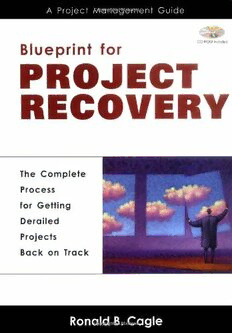Table Of ContentBlueprint for
Project Recovery—
A Project
Management Guide
Y
L
F
M
A
E
RTonald B. Cagle
AMACOM
Team-Fly®
Blueprint for
PROJECT
RECOVERY—
A Project
Management Guide
..........................9758$$ $$FM 12-09-0208:29:09 PS
This Page Intentionally Left Blank
..........................9758$$ $$FM 12-09-0208:29:10 PS
Blueprint for
PROJECT
RECOVERY—
A Project
Management Guide
The Complete Process for Getting Derailed Projects Back on Track
Ronald B. Cagle
AmericanManagementAssociation
NewYork•Atlanta•Brussels•BuenosAires•Chicago•London•MexicoCity
SanFrancisco•Shanghai•Tokyo•Toronto•Washington,D.C.
..........................9758$$ $$FM 12-09-0208:29:16 PS
SpecialdiscountsonbulkquantitiesofAMACOMbooksare
availabletocorporations,professionalassociations,andother
organizations.Fordetails,contactSpecialSalesDepartment,
AMACOM,adivisionofAmericanManagementAssociation,
1601Broadway,NewYork,NY10019.
Tel.:212-903-8316.Fax:212-903-8083.
Website:www.amacombooks.org
Thispublicationisdesignedtoprovideaccurateandauthoritative
informationinregardtothesubjectmattercovered.Itissoldwiththe
understandingthatthepublisherisnotengagedinrenderinglegal,
accounting,orotherprofessionalservice.Iflegaladviceorotherexpert
assistanceisrequired,theservicesofacompetentprofessionalpersonshould
besought.
Variousnamesusedbycompaniestodistinguishtheirsoftwareandother
productscanbeclaimedastrademarks.AMACOMusessuchnames
throughoutthisbookforeditorialpurposesonly,withnointentionof
trademarkviolation.Allsuchsoftwareorproductnamesareininitial
capitallettersorALLCAPITALletters.Individualcompaniesshouldbe
contactedforcompleteinformationregardingtrademarksandregistration.
Alistofthesetrademarkscanbefoundonpage273followingthe
bibliography.
LibraryofCongressCataloging-in-PublicationData
Cagle,RonaldB.
Blueprintforprojectrecovery:aprojectmanagementguide:thecompleteprocessforgettingderailed
projectsbackontrack/RonaldB.Cagle.
p. cm.
Includesbibliographicalreferencesandindex.
ISBN0-8144-0766-8(hardcover)
1.Projectmanagement.I.Title.
HD69.P75C3452003
658.4(cid:1)04—dc21 2002011733
(cid:2)2003RonaldB.Cagle
Allrightsreserved.
PrintedintheUnitedStatesofAmerica.
Althoughthispublicationissubjecttocopyright,permissionisgrantedfreeofchargetoreproducetheforms
thatarerequiredbyeachuserandtoprintandusepagesfromtheenclosedCD-ROM.Onlytheoriginal
purchasermaymakecopies.Undernocircumstancesispermissiongrantedtosellordistributeona
commercialbasismaterialreproducedfromthispublication.
Exceptasprovidedabove,thispublicationmaynotbereproduced,storedinaretrievalsystem,ortransmitted
inwholeorinpart,inanyformorbyanymeans,electronic,mechanical,photocopying,recording,or
otherwise,withoutthepriorwrittenpermissionofAMACOM,adivisionofAmericanManagement
Association,1601Broadway,NewYork,NY10019.
Printingnumber
10 9 8 7 6 5 4 3 2 1
..........................9758$$ $$FM 12-09-0208:29:17 PS
TABLE OF CONTENTS
PREFACE xiii
ACKNOWLEDGMENTS xvii
CHAPTER 1
GETTING STARTED 1
1.1 General 3
1.2 Requirements 7
1.3 The Search Methodology 7
CHAPTER 2
CHECKING PROGRAMMATIC PERFORMANCE 9
2.1 General 9
2.2 Programmatic Performance Checklist 9
2.3 Programmatic Explanations 10
CHAPTER 3
CHECKING TECHNICAL PERFORMANCE 38
3.1 General 38
3.2 Technical Performance Checklist 38
3.3 Technical Explanations 41
v
..........................9758$$ CNTS 12-09-0208:29:08 PS
vi TABLE OF CONTENTS
CHAPTER 4
RECOVERING FROM PROGRAMMATIC PROBLEMS 56
4.1 General 56
4.2 Programmatic Recovery Checklist 56
4.3 Programmatic Recovery Cause Descriptions 58
CHAPTER 5
RECOVERING FROM TECHNICAL PROBLEMS 109
5.1 General 109
5.2 Technical Search Tables 109
5.3 Technical Recovery Cause Descriptions 112
CHAPTER 6
EXPANDING THE CAUSE BASE FOR YOUR PROJECT 156
6.1 General 157
6.2 Brainstorming 158
6.3 Researching Appropriate Benchmarks 160
6.4 Researching the Processes 161
6.4.1 Standard Processes 161
6.4.2 Customer Processes 162
6.4.3 Enterprise Processes 162
6.4.4 Project/Program Processes 162
CHAPTER 7
GROUPING THE CAUSES FOR ACTION 165
7.1 General 165
7.2 Ordering Techniques 165
7.2.1 85:15 Rule 166
7.2.2 Cause and Effect Diagram 167
7.2.3 Affinity Diagrams 171
7.2.4 Relationship Diagrams 173
7.3 Interrelationships of Causes 176
..........................9758$$ CNTS 12-09-0208:29:08 PS
TABLE OF CONTENTS vii
CHAPTER 8
SELECTING THE BEST OF THE BEST 177
8.1 General 177
8.2 Evaluation Techniques 178
8.2.1 Pareto Analysis 178
8.2.2 Force Field Analysis 180
8.2.3 Failure Mode Effect Analysis (FMEA) 182
8.2.4 Monte Carlo Simulation 184
8.3 Eliminating Holes and Overlaps 186
8.4 Choosing the Causes 187
CHAPTER 9
IMPLEMENTING THE TAILORED CHANGES 188
9.1 General 188
9.2 Implementation Techniques 188
9.2.1 Slipping in the Fix 189
9.2.2 Creating ‘‘On-Ramps’’ 189
9.2.3 ‘‘Dumping’’ the Fix 190
9.3 Selecting Your Technique 190
CHAPTER 10
CONCLUDING 191
10.1 General 191
10.2 The Concluding Process 192
10.2.1 Quantum Improvement 192
10.2.2 Documentation 193
10.3 Data Trail 195
10.4 Modifying Methods 196
CHAPTER 11
USING THE COMPACT DISK (CD) 197
11.1 General 197
11.2 Loading 198
11.3 Using the Tables 198
11.4 Using the Attachments 198
..........................9758$$ CNTS 12-09-0208:29:09 PS
viii TABLE OF CONTENTS
SUMMARY 199
GLOSSARY 203
ATTACHMENTS 217
1 Standard Program Plan Outline 219
2 Standard Technical Plan Outline 223
3 Risk Mitigation Plan 227
4 Contract/Subcontract Outline 231
5 Configuration Management Plan Outline 234
6 Quality Assurance Plan Outline 237
7 Requirements Traceability Matrix 241
8 Requirements Flow-Down Matrix 245
9 Data Delivery Matrix 247
10 Capability Matrix 249
11 Policy-to-Plan Trail 251
12 Experience Window 253
13 Standards Traceability Matrix 255
14 Vendor Evaluation Process 258
15 Design Review Approval Form 263
16 In-Process Review Approval Form 265
17 Negotiation Checklist 267
18 Critical Success Factor (CSF) Matrix 269
BIBLIOGRAPHY 271
..........................9758$$ CNTS 12-09-0208:29:09 PS
FIGURES
Figure 1-1 Project/Program Environment 2
Figure 1-2 Project/Program Requirements Control
Relationships 4
Figure 1-3 Documentation Interrelationships 5
Figure 2-1 Vendor Evaluation Sheet 32
Figure 4-1 Vendor Evaluation Sheet 93
Figure 5-1 Requirements Allocation 123
Figure 5-2 Design Review Approval Form 128
Figure 5-3 In-Process Review Approval Form 130
Figure 7-1 Fishbone Diagram 168
Figure 7-2 Tree Diagram 169
Figure 7-3 Affinity Diagram 172
Figure 7-4 Relationship Diagram 174
Figure 8-1 Pareto Analysis: Raw Data 179
Figure 8-2 Pareto Analysis: Ordered Data 179
Figure 8-3 Force Field Schematic 181
Figure 10-1 A Typical Traditional Library 194
Figure 10-2 Schematic of an Electronic Library 195
Figure A3-1 Risk Mitigation Form 228
Figure A13-1 Policy-to-Program Plan to Support Document Flow 257
Figure A14-1 Vendor Evaluation Sheet 260
Figure A14-2 Vendor Evaluation Summary 261
Figure A14-3 Vendor Selection Summary Score Sheet 262
Figure A15-1 Design Review Approval Form 264
Figure A16-1 In-Process Review Approval Form 266
ix
..........................9758$$ FIGS 12-09-0208:29:14 PS

